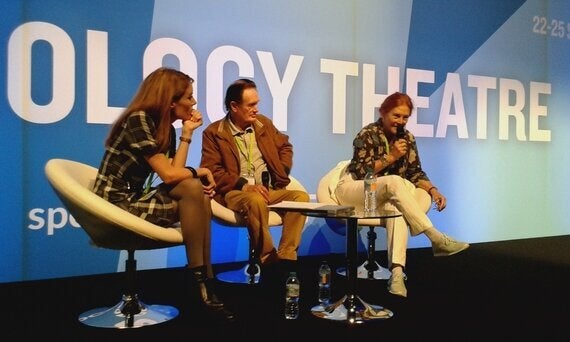On Saturday 24th of September I took part in a panel discussion at New Scientist Live - a large, ambitious consumer tech expo hosted by the leading science magazine, at the Excel Centre in London.
I was fortunate to share the stage with two established luminaries of the science/art world. Martin Kemp is a world expert on Leonardo da Vinci, and Liliane Lijn was one of the first sci-art practitioners, and continues to lead the way in her fascinating fields of laser sculpture, massive sun-focussing prisms, and more.
The title on our screen was something like 'Science, Art and the Sublime', but we had been thinking, too, about technology and beauty after being primed with the question, 'Can technology ever be beautiful?'
It was one of those situations where there would probably never have been enough time to get to grips with the subject(s), and there were many more ideas I'd like to have tested, and questions I'd have loved to have asked those two, and the audience, about.

I suppose I was there as the representative of contemporary technology, and someone who has examined it for its potential for beauty and relevance over the years. Now, beauty is one thing; the sublime is a different kettle of fish altogether. It isn't really a concept we associate with technology, it's a philosophical, and even rather theosophical notion. But we are emotional beings, and the more I think about it, the more it strikes me that it might be a more useful way to make sense of what's happening with digital than the usual conflation of tech and science.
When an audience member asked for examples of the sublime, Liliane said of her work: "What's more sublime than our sun?" A fine point, because of course sublime doesn't just mean impressive, beautiful, or 'beyond' - it also means a sort of horror. The sublime is the appallingly incomprehensible and unaccountable, driving in us a devastating awareness of our own limitations. The Sun inspires awe; its impact, origin and reasons vastly beyond our imagining. It controls life on our planet, it operates on a scale we have to take on faith, and we cannot alter its whims. We are at its mercy.
But when I started to think about it, I realised we feel helpless and impressed by technology's incomprehensibility in some ways, too. Digital messes with our perceived scales of significance, one moment reminding us how little we know, and how little we are, the next, making us feel all-powerful, with magical fingers.
The sublime is the appallingly incomprehensible and unaccountable, driving in us a devastating awareness of our own limitations.
There's a funny thing going on, here. The more mysterious and abstract computing becomes, the more we revere it and, not coincidentally, the more power it has. And the more power it has, the more power we afford to the people who take on the role as its gatekeepers. So the 'sublime' (if we can call it that) perception of digital is part of what has made it so successful. And of course, it's self-reinforcing.
Tech gallops across the world on mystery and fear. The computation process becomes more mysterious to us with time. With time, tech gets smaller and faster and weirder, to the point where we really can only work at a great distance, through a tunnel of increasingly abstract interpreters. We are monkeys poking long sticks into a termite mound. And, to grind the metaphor gears a bit (sorry), we dress tech's mystery in a sarcophagus of metal and glass like a sort of alien King. Our response to the unfathomable-ness of tech is to encase it in a sort of cartoon of that mystery. It's more than design fetish, it's techno-faith.

I talked a bit, at this event, about the journey we have come on. We are leaving behind the intuitions of industry where technical things, to put it basically, look like what they do. Tech is increasingly incomprehensible to human eyes. Indeed, that might even be the hallmark of digital - it's the technology known only at a distance, through its traces.
So: this void opening up between what things look like and what they actually do, has it swallowed anything up? Have we lost anything on our journey from jacquard looms to techno-faith? We all need something to believe. Does it matter if our need to be awestruck by power is transferring from deities to shiny, stroke-able objects?
The photos in this post were taken by Judd Flogdell